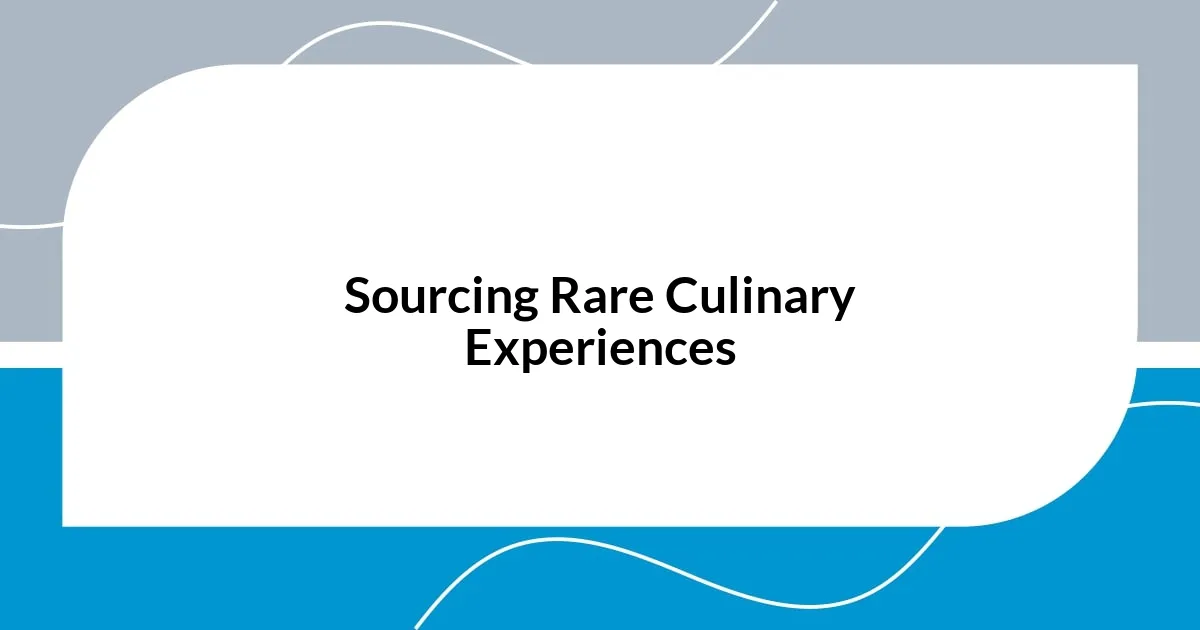Key takeaways:
- Culinary creativity flourishes through experimentation with unexpected ingredient combinations, leading to delightful surprises.
- Understanding and utilizing unique ingredients, such as black garlic and saffron, can transform dishes and elevate flavors.
- Food serves as a cultural connector, with traditional recipes evolving through fusion and personal experiences enriching culinary adventures.
- Embracing new cooking techniques and sourcing rare ingredients can deepen one’s appreciation and connection to food.

Exploring Culinary Creativity
When I think about exploring culinary creativity, I can’t help but remember the time I decided to fuse traditional sushi with local BBQ flavors. It was a spontaneous decision, but the thrill of trying something completely new ignited a spark of excitement within me. Have you ever had that moment when a flavor combination surprises you by just how well it works?
Experimentation plays a crucial role in culinary creativity. I often find myself rummaging through my pantry, combining what seems like mismatched ingredients. One day, a few leftover herbs, nuts, and a bit of honey transformed into a delightful pesto that topped my pasta beautifully. This experience taught me that limitations can often lead to the most unexpected and delicious results, urging us to think beyond the conventional recipe.
There’s a kind of magic in bringing unexpected elements together on a plate, don’t you think? I recently attended a dinner party where the host paired dark chocolate with chili-infused olive oil, and the explosion of flavor was unforgettable. It made me realize that culinary adventures can also be a wonderful way to connect with others, as sharing unique dishes often leads to stories and laughter that create lasting memories.

Understanding Unique Ingredients
Understanding unique ingredients can truly elevate a dish from the ordinary to the extraordinary. I remember one intriguing encounter with black garlic, which I came across at a local farmers’ market. Its sweet, caramel-like flavor completely transformed my approach to sauces and marinades. Have you ever tasted something that made you rethink how you use traditional ingredients?
Another ingredient that caught me off guard was saffron, often touted as one of the most expensive spices in the world. I was hesitant to purchase it initially due to its price, but once I incorporated a pinch into a risotto, the complex aroma and rich color it brought were worth every cent. It’s funny how one unique element can redefine a whole dish, adding an allure that’s hard to resist.
I’ve also dabbled with edible flowers, which not only add stunning visuals to a plate but also impart subtle flavors. The first time I used nasturtiums in a salad, their peppery taste was a delightful surprise. It reminded me how food can be a canvas for creativity, blurring the lines between art and eating. Have you ever experimented with something unexpected that turned into a culinary masterpiece?
| Ingredient | Flavor Profile |
|---|---|
| Black Garlic | Sweet, caramel-like |
| Saffron | Floral, complex |
| Nasturtiums | Peppery, herby |

Adventurous Cooking Techniques
There’s something exhilarating about embracing adventurous cooking techniques. I once tried sous-vide cooking, a method where you vacuum-seal food in a bag and cook it to a precise temperature in a water bath. It felt like a sci-fi culinary experiment, and the result was a perfectly tender steak that melted in my mouth. The confidence gained from dabbling in this technique inspired me to explore more fun methods like smoking with wood chips, adding an unmistakable depth of flavor to everything from vegetables to seafood.
Some adventurous techniques I personally enjoy include:
- Sous-vide cooking: Precise temperature control ensures perfect doneness.
- Fermentation: This process imparts unique flavors to foods like kimchi and kombucha.
- Ceviche preparation: The citrus “cooks” raw fish, transforming it into a zesty dish.
- Molecular gastronomy: Experimenting with techniques like spherification, where liquids are turned into gel-like spheres, changes the way we experience flavors.
Each time I explore these methods, I feel like a culinary scientist, and it deepens my love for the art of cooking. It’s about pushing boundaries and discovering new dimensions of taste that I never knew existed. Have you ever felt that thrill of experimentation in the kitchen?

Cultural Influence on Cuisine
Cultural influences significantly shape our culinary experiences, often transcending geographical boundaries. I vividly recall a dinner I attended featuring Moroccan cuisine, where each dish was a tapestry of spices like cumin and coriander. The warmth and contrast of flavors reminded me how food can be a reflection of a culture’s history and storytelling—each bite a narrative of its people.
Exploring different cuisines has led me to discover how ingredients like lemongrass in Thai dishes or chili in Mexican cooking can evoke deep emotional ties to those cultures. Once, while preparing a homemade pho, the aromatic basil and lime transported me back to my travels in Vietnam. Have you ever cooked a dish that brought you to another part of the world, if only for a moment?
It’s also fascinating how traditional recipes evolve when they mingle with other cultural elements. For instance, I’ve seen Italian pasta incorporate Asian noodles, creating fusion dishes that celebrate the best of both worlds. This blending of flavors invites creativity in cooking—making each meal an opportunity to explore a rich history of culinary traditions. Isn’t it thrilling to think about how food connects different cultures?

Personal Stories Behind Dishes
I’ve always believed that food tells a story, often connected to people and experiences. One night, I decided to recreate my grandmother’s famous chicken soup, a dish that warmed my heart throughout my childhood. As I chopped vegetables and let the broth simmer, the familiar smell transported me back to her cozy kitchen, a place filled with love and laughter. Have you ever noticed how certain aromas can evoke powerful memories?
One particularly memorable dish for me is paella, which I first encountered during a colorful festival in Spain. The vibrant mix of saffron rice, seafood, and fresh vegetables was not just a meal but a celebration. As I watched the chef expertly layer the ingredients, I felt a genuine connection to the culture, realizing that food is a communal experience. I often wonder how many stories are woven into every dish we share, don’t you?
On a more adventurous note, I once attempted to recreate an elaborate dish I enjoyed in a bustling night market in Thailand—mango sticky rice drizzled with coconut cream. As I painstakingly layered the flavors, I felt a unique connection to the street vendors who made it with so much love. The first taste was a delightful rush, reminding me of the joyful chaos of the market and the smiles of the people around me. Isn’t it fascinating how a single dish can connect us to places and faces we may never see again?

Sourcing Rare Culinary Experiences
Sourcing rare culinary experiences often requires a bit of adventure and creativity. I remember my quest for a specialty ingredient for a unique dish—black garlic. Its sweet, earthy flavor can elevate any recipe, but finding it locally was a challenge. After searching countless shops, I finally stumbled upon a little farmer’s market. The vendor, a passionate chef, shared stories about its origins and uses in his family recipes. Isn’t it amazing how food can create connections between strangers with a shared love for flavor?
I often look for culinary experiences that push the boundaries of my comfort zone. One time, I joined a foraging tour in the woods to learn how to identify wild edibles. It was thrilling to pick fresh ramps and wild garlic—ingredients that are nearly impossible to find in a grocery store. As we cooked the foraged goods over an open fire, I felt a deep respect for the land and its bounty. Have you ever tasted something you grew or found yourself? That raw connection can transform a simple meal into a profound experience.
Traveling also opens the door to rare culinary finds that can redefine your palate. I vividly recall a street fair in Portugal where I discovered a dish called “sardinhas assadas,” simply grilled sardines. The smoky aroma wafting through the air was enticing, and biting into that perfectly grilled fish reminded me of the ocean, thanks to the chef’s expertise. How often do we take a culinary leap and end up with unforgettable memories? That spicy, salty taste became a benchmark for all future seafood experiences.

Tips for Trying New Foods
Trying new foods can be an exhilarating adventure, and I’ve picked up a few tips along the way. One of my favorites is to start small—try a dish with ingredients that are partially familiar to you. I remember the first time I dared to order sushi at a local joint. I took a bite of a California roll, and my taste buds tingled with curiosity. It was a gateway to new flavors, opening my mind to the possibilities beyond my usual choices. What’s a food you’ve always thought about but hesitated to try?
When diving into unfamiliar cuisines, I often read up on the culture behind the dishes. Understanding the origins can deepen your appreciation and enhance the experience. I once learned about the spices used in Indian cooking, which led me to finally try a vibrant curry. The bursts of flavor transported me—each sip told a tale of tradition and warmth. Have you ever felt that connection when enjoying a meal? It truly makes the experience richer.
Sharing the experience can also make trying new foods less daunting. I recall a dinner with friends where we ordered a wide array of tapas. With each bite of something exotic, we encouraged each other, laughing and sharing our thoughts. That collective enthusiasm made me more adventurous than I would have been alone. Isn’t it wonderful how the right company can turn a simple meal into an unforgettable experience?